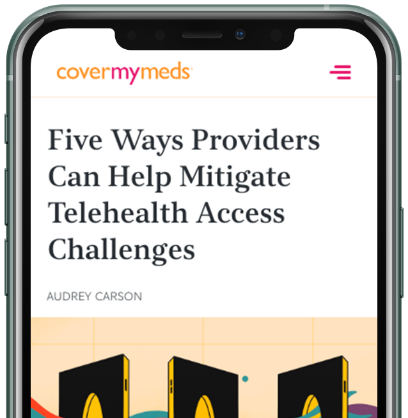Informed Decisions at the Point-of-Prescribing
Life science companies are working hard to expand the limits of what is medically possible. Their cutting-edge research is evolving novel therapies to replace limited-efficacy medications, as well as first-in-class treatments for previously-incurable diseases.

Despite availability of remarkable treatments, patients often encounter obstacles to wellness related to hefty out-of-pocket costs associated with drug prices, copays, deductibles and general lack of options for affording therapies.
A recent survey found that 75 percent of patients have been surprised at the cost of a prescription and 37 percent have abandoned therapies due to cost.Real-time Benefit Check National Adoption Scorecard Research from the National Center for Health Statistics found that nearly eight percent of Americans did not take their medication as prescribed to save money,Strategies Used by Adults to Reduce Their Prescription Drug Costs, National Center for Health Statistics with other experts saying that such cost-related nonadherence can be as high as 20 percent.When the Cost of Medications Keeps Patients from Taking Them, Managed Care
Innovations in health care technology have made substantial impact in helping patients get the medications they need to live healthy lives. Solutions such as electronic prior authorization (ePA) have streamlined slow, expensive and burdensome processes to help improve medication access and outcomes for patients and providers.
Beyond ePA, real-time benefit check (RTBC) is a technology capable of helping providers and patients navigate coverage requirements and prescription benefits. Advanced RTBC solutions, like RxBenefit Clarity™, provide a comprehensive, patient-specific analysis to identify opportunities that help patients afford their medications and clear up uncertainty about out-of-pocket costs.
RxBenefit Clarity is also able to inform on the availability of affordability services (e.g. eVouchers, copay savings cards and patient assistance programs) for certain medications along with pharmacy-specific cash prices of drugs. As a result, providers have better transparency during clinical decision-making to consider the particular medical and financial situations of patients – more options are available beyond switching to formulary alternatives when out-of-pocket costs stress patients’ budgets. If this should mean that the appropriate medication requires a PA, then a request can be started in workflow electronically and determinations are often returned automatically (nearly half are auto-determined and 93 percent are determined in less than or equal to three days).CoverMyMeds data on file, 2018
Real-time benefit check solutions can lead to a productive conversation between patients and providers on drug efficacy and affordability. When patients are equipped with all the necessary information to make informed personal health decisions – including medical recommendations and out-of-pocket costs (after reviewing insurance coverage, patient assistance programs and cash price for drugs) – they may be less susceptible to sticker shock at the pharmacy and remain adherent to prescribed therapies.
To learn more about the value of RTBC solutions, check out the 2018 Real-Time Benefit Check National Adoption Scorecard.
The latest healthcare insights, floated right to your inbox.



